COMDEKS Project: Weto Range, Ghana
06.03.2017
-
SUBMITTED ORGANISATION :
-
United Nations Development Programme (UNDP); Ministry of the Environment, Japan; Secretariat of the Convention on Biological Diversity; United Nations University (UNU)
-
DATE OF SUBMISSION :
-
06/03/2017
-
REGION :
-
Western Africa
-
COUNTRY :
-
Ghana (Volta Region)
-
SUMMARY :
-
The Community Development and Knowledge Management for the Satoyama Initiative Programme (COMDEKS) was launched in 2011 to support local community activities that maintain and rebuild target production landscapes and seascapes, and to collect and disseminate knowledge and experiences from successful on-the-ground actions so that, if feasible, they can be adapted by other communities throughout the world to their specific conditions. The programme provides small-scale finance to local community organizations in developing countries to support sound biodiversity and ecosystem management as well as to develop or strengthen sustainable livelihood activities planned and executed by community members themselves. The target landscape for the COMDEKS project in Ghana is the Weto Range, which forms the southern part of the Togo-Atakora Range, a belt of ridges and hills beginning west of Accra and extending northeast into Togo and Benin.
-
KEYWORD :
-
Agriculture, Forests, Ecosystem conservation
-
AUTHOR:
-
United Nations Development Programme (UNDP)
-
LINK:
-
http://collections.unu.edu/eserv/UNU:6011/communities_in_action_comdeks.pdf#page=78
Summary Sheet
The summary sheet for this case study is available here.
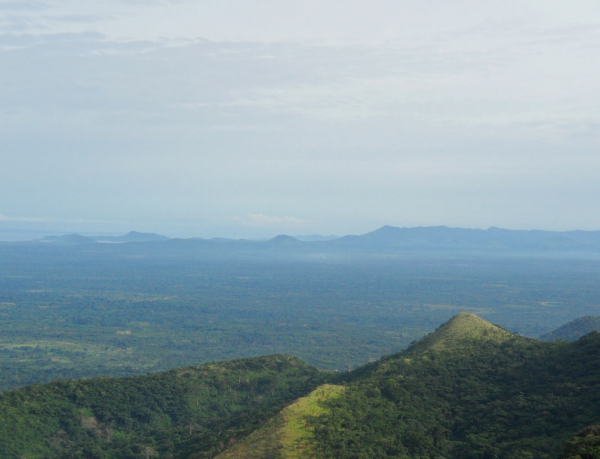
The Landscape
Geography
The target landscape for the COMDEKS project in Ghana is the Weto Range. The Weto landscape forms the southern part of the Togo-Atakora Range, a belt of ridges and hills beginning west of Accra and extending northeast into Togo and Benin. The average elevation of the Weto Range is 450 meters, with very deep and relatively narrow valleys. Ghana’s highest point, Mount Afadjato (885 meters), is located in this range.
The project area within the Weto range measures about 15,000 hectares and spans eleven traditional and three political administrative areas, namely, the South Dayi District Assembly, and Hohoe and Ho municipalities in the Volta region. The area is a mountainous mosaic landscape with diverse habitats and land uses, including cities, towns, and villages; farmlands with adjacent cocoa, oil palm, avocado and mango plantations; and natural forests, grasslands, wetlands, and water bodies. There are some 180 streams and rivulets located in the project area; Volta Lake and Dayi River are two major aquatic resources utilized for aquaculture and irrigation within the landscape.
The area has a tropical savannah climate, characterized by moderate temperatures of 12 -25oC. Annual rainfall follows a bi-modal pattern and ranges from 714-1100 mm, with the highest rainfall in the central highland areas and in the forest zone. The area consists of a generally rugged complex of folded strata, with many prominent heights composed of volcanic rock. Heavy clay loams, sandy loams and alluvial soils are the common soil types in the valley areas.
Biological Resources and Land Use
The Weto range is well-endowed with a diversified natural resource base in the form of high biodiversity, hydrological systems, rich soils, and a conducive climate, all of which form a strong base for economic activities and sustainable development. As part of the Guinean Forest of West Africa, the Weto Range has been identified by IUCN as a biodiversity hotspot of global significance. The area contains at least 1,500 species of endemic plants, but has lost at least 70 percent of its original habitat (Conservation International, 2000). In addition to its rich endemic flora, the Weto Range landscape has a rich wildlife, including birds, bats, rodents, monkeys, waterbuck and butterflies.
The most common vegetation in the landscape is open forest (51 per cent of the total land area), which is comprised of a mixture of food crop farms, bush fallows, and cash crops like oil palm, oranges, and timber plantations. Closed forests (23 per cent of total area) are mostly community-conserved areas, sacred groves and mountain vegetation above 80 percent gradient. The built-up area constitutes only about 5 percent of the total area.
The range is highly heterogeneous in agricultural biodiversity and food systems. On the high slopes different tree species exist, especially within the sacred sites. Different traditional farming systems that promote the conservation of biodiversity exist along the range. Local knowledge about agricultural biodiversity is high, with farmers practicing traditional agroforestry, where trees are left on farms and integrated with growing crops like cocoa, plantain, cassava, mango, and pear. Strips of land along water bodies are left uncultivated, with their maintenance guided by local belief systems and taboos. The traditional slash-and-burn practice is still in use, with a fallow period of not less than 3 years needed to restore soil fertility. Locally cultivated food forms the basis of more than 70 percent of the local dishes eaten.
There are over 90 caves of social and religious significance and are communally revered as either the abode for the gods, or having historically served as hiding places during wars. The caves now serve as shelter and habitat for animals like pythons, birds, bats, and special animals that are totems for the people. There are 136 traditionally protected forests (sacred groves) of varying sizes ranging from 0.2 ha to 15 ha. The most significant groves are Kale, Weto, Tandze, Dienor, Hator, Obudiaye (monkey sanctuary), which are 10 ha or more in area, and serve as homes to important deities worshipped by the people.
Socioeconomic Context
The population of the three districts is 580,588 people (2010 Census) with an annual growth rate of 1.9 percent, and a comparatively high literacy rate. The major ethnic groups are Ewes (90 percent), Akans (6 percent), and Northerners (4 percent). The average annual household income in the area is about GH¢2,430.00 (US$1,200), while the average per capita income is almost GH¢800 (US$400.00). Approximately 20 percent of the population lives below the national poverty line.
Farming, hunting, and petty trading are the main subsistence activities. Farm holdings range from one-half to two hectares of arable land, with farmers engaging in mixed-cropping along the slopes of the mountains or in the relatively flat valley terrain. Among the cash crops cultivated in the area are avocados, pears, oranges, mangoes, pineapples, bananas, oil palm and cocoa. The main food crops are plantain, sweet potatoes, rice, maize, cassava, legumes, and vegetables. Other subsistence activities include small ruminant rearing, cattle ranching and artisanal fishing. About 46 percent of all households in the area operate non-farm enterprises, with women operating 72 percent of these businesses.
Key Environmental and Social Challenges
The main environmental challenges confronting the landscape are increasing habitat destruction; unsustainable farming practices; inadequate livelihood support systems and weak institutional capacity to support conservation and production. Extensive forest degradation has occurred due to poor agricultural practices such as slash and burn, as well as illegal logging and frequent bush fires. Removal of vegetative cover on slopes has led to serious erosion, loss of soil fertility, and an increase in landslides. Loss of forest cover has also resulted in a reduction in stream volumes and soil moisture. The result of these environmental challenges has been increased loss of biodiversity, reduced ecosystem services, land degradation, lower agricultural production, and widespread poverty.
Lack of adequate livelihoods is one root cause for the area’s environmental challenges, as people turn to the forest to meet their subsistence needs. Agricultural production and income is low due both to poor farming practices and lack of access to technology and high-quality seeds and other inputs. Reduced soil fertility means that farmers who once harvested 7-8 bags of maize per acre now get only 2-4 bags, decreasing income and increasing food insecurity. Lack of employment opportunities beyond subsistence agriculture in turn fuels out-migration, particularly among the young, and destabilizes communities.
COMDEKS Activities, Achievements, and Impacts
Community Consultation and Baseline Assessment
To begin the COMDEKS process in Ghana, the SGP Country Programme in Ghana, in collaboration with the Development Institute and the three District Assemblies within the Weto landscape, held a series of community level meetings and a district workshop in April 2012 to introduce the concept of integrated management of socio-ecological production landscapes, and to discuss the COMDEKS implementation strategy. Over 50 stakeholders, including civil society organizations operating in the area, traditional rulers, government service providers, opinion leaders, District Assembly members, religious groups and farmers, attended the workshop, which was funded by the District Assemblies. The participating groups subsequently agreed in 2012 to form a “WETO platform”—a formal affiliation of these groups—to galvanize resources to support the implementation of landscape-level activities.
The Weto Range was jointly identified as the target landscape and geographical area for the COMDEKS project by Traditional Authorities in the eleven traditional areas, non-governmental organizations (NGOs) operating on the Weto Range, local people living on the landscape, and the three District Assemblies. The selection of the Weto landscape was validated with the community leaders, landowners and traditional authorities through a series of community meetings spearheaded by the WETO NGO Platform. As part of this community consultation process, village-level meetings and focus group discussions were organized with the 36 selected communities in the target landscape.
The baseline assessment of the target landscape began with village-level discussions in 36 communities, organized and facilitated by the Development Institute, a national NGO. During these local discussions, all community members were given a chance to express their knowledge of the landscape. More than 1600 people participated in this part of the process. Additional focus-group discussions took place involving key opinion leaders in the communities to elicit more details. Finally, a one-day landscape-wide workshop took place in June 2012, during which the set of landscape resilience indicators developed for the Satoyama Initiative by the United Nations University and Bioversity International were used to score landscape conditions and trends.
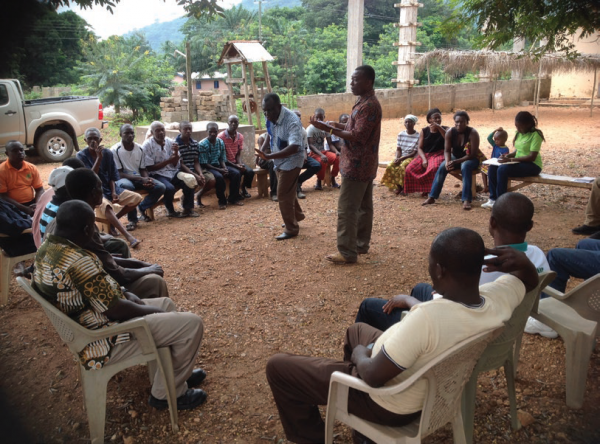
National Steering Committee members interact with grantees, COMDEKS Ghana
During the baseline assessment workshop, community resource mapping activities and a GIS map developed by the Centre for Remote Sensing and Geo-Information Services (CERGIS) at the University of Ghana, Legon, were used to provoke discussions, identify community assets, and assess the current situation on the range. Stakeholders were also asked to identify potential community-based activities to manage the Weto Range towards the goal of landscape resilience.
The community consultation process was conducted in the native Ewe language spoken in the target area, in order to encourage maximum participation, ensure good understanding of the issues, and allow for a more meaningful discussion with local communities. Stakeholders were selected to represent the variety of communities and regions within the larger Weto landscape: the east and west sides of the Weto range, lowland and highland areas, a configuration of traditional areas, downstream and upstream communities, and adjacent and contiguous communities. This diversity of stakeholders was helpful in addressing cross-boundary problems such as bushfires, chain sawing, illegal harvesting of trees and uncontrolled hunting. In addition, a special effort was made to include women the process, with women making up nearly 60 percent of all participants. Women’s participation was especially important at the focus-group level, where 36 Queen Mothers—one from each settlement—participated. Queen Mothers play a critical role in traditional governance of communities in Ghana.
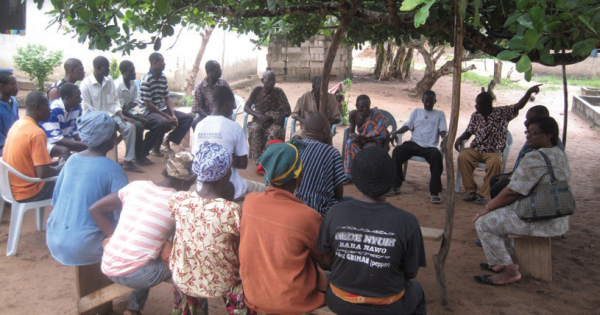
Participatory stakeholder workshop, COMDEKS Ghana
The baseline assessment gave key stakeholders a snapshot of the landscape’s social, economic, and environmental situation, including the status of the area’s natural resources. This snapshot helped the communities understand their recent lack of stewardship towards their environmental endowments. In the process, it developed time series environmental data in the form of maps for the landscape that have proven essential in landscape planning and will be the foundation of future performance assessments. The associated workshop provided an opportunity for the local community and the local government to sit together and discuss environmental problems affecting the target landscape, and possible land use planning and management responses. The net effect was an increased commitment to stronger stewardship of natural resources.
Landscape Strategy
The baseline assessment and community consultation process led to the development of a COMDEKS Country Programme Landscape Strategy for Ghana, a comprehensive document that, based on priorities identified by landscape stakeholders, outlines the landscape profile, expected goals and outcomes, and key measures and strategies for community-based actions.
- The WETO Landscape Strategy vision: “A thriving socio-ecological production landscape where the local communities are actively involved in the sustainable management and utilization of the natural resources for increased production, the restoration of biodiversity, wealth creation and continuous flow of ecosystem services.”
To give greater definition to this vision, the Landscape Strategy sets out a slate of four interconnected outcomes meant to increase landscape resilience in four critical areas. Table G-1 lists these landscape outcomes for the Weto Range, along with the performance indicators that will be used to assess the extent to which these outcomes have been achieved.
Table G-1: Landscape Outcomes and Indicators from the Ghana Landscape Strategy
| Landscape Outcomes | Key Performance Indicators |
| Outcome 1:
Natural and semi-natural habitats and ecosystem services within the WETO landscape (watershed, sacred groves, wildlife habitats, and agro-biodiversity areas) are conserved. |
· Number of hectares of degraded ecosystems in the landscape brought under sustainable land/resource management.
· Number of people and percentage of communities participating in biodiversity conservation and sustainable land management activities funded by COMDEKS (disaggregated by gender). |
| Outcome 2:
Sustainable agricultural practices are implemented across the landscape to enhance and revive traditional conservation and production practices and adoption of new technologies. |
· Number of hectares where more sustainable land use and agricultural practices have been implemented, by type (i.e. traditional and innovative practices).
· Number of communities participating in sustainable agricultural practices promoted by COMDEKS at the landscape level (disaggregated by gender). |
| Outcome 3:
Livelihood and wellbeing of target social groups within the landscape are sustained and enhanced through the development of livelihood enterprises in line with the local tradition and culture. |
· Increase in household income and assets as a result of supported activities.
· Number and type of livelihood enterprises (and/or alternative income sources) established and sustained.
|
| Outcome 4:
Strengthened institutional capacity at the landscape level to realize the goal of integrating conservation and production in the management of the target landscape. |
· Number of institutions created or strengthened that are engaged in integrated landscape management.
· Number and type of plans and decisions relevant for the target landscape that have been agreed and implemented. · Number of COMDEKS lessons learned and best practices captured at the program level. |
Community-Led Landscape Projects
Based on the feedback from the community consultation process, the Landscape Strategy for Ghana prioritized the following activities and interventions:
- Conservation and restoration of ecosystems within the Weto landscape through forest restoration, restoration and protection of wetlands and watersheds, and installation of soil and water retention structures;
- Sustainable production of crops, livestock, fish, forest, and non-timber forest products; diversification of agricultural landscapes and production systems;
- Development of new livelihood enterprises, including new value-added agricultural activities as well as ecotourism and cultural tourism;
- Promotion of participatory community-based land use planning, and adoption of action plans to prevent rapid degradation of wildlife and water resources ;
- Building the institutional capacity needed to realize the goal of integrating conservation and production;
- Protection of areas of significant ecological importance or areas known to contain medicinal plants, including sacred groves and caves, as well as fragile areas such as hill slopes, wetlands, and estuaries;
- Strengthening conflict resolution mechanisms in natural resource management by building upon traditional as well as new institutions and authorities to reduce insecurity and increase economic opportunities.
With these guidelines in mind, 10 local projects were selected for Ghana’s portfolio of COMDEKS landscape interventions in the Weto Range (see Table G-2). Each is focused on a subregion within the larger Weto Range, and each is led by a different local NGO or foundation. Proposals for these projects, which grew out of the adopted Landscape Strategy, were vetted by the Ghanaian National Steering Committee of the GEF Small Grants Programme and approved for grants ranging from US$6,000 to $30,000. Projects generally contain a mix of activities addressing two or more of the overarching Landscape Outcomes from the Landscape Strategy, with elements of ecosystem restoration, agricultural extension, capacity building, and institution-building. Nearly all projects also have an enterprise development component in recognition of the importance of improving the environmental sustainability and income potential of local livelihoods.
Lorem ipsum dolor sit amet, consectetur adipiscing elit. Ut elit tellus, luctus nec ullamcorper mattis, pulvinar dapibus leo“Initially we did not understand, but the COMDEKS strategy and approach has won our hearts. Today the mountain is forested, we farm to get more yield, our youth have been mobilized to invest in bee keeping and the wild animals are coming back, including royal pythons, antelopes, and red hogs.”
–Mr. Jabu, Avenui Community
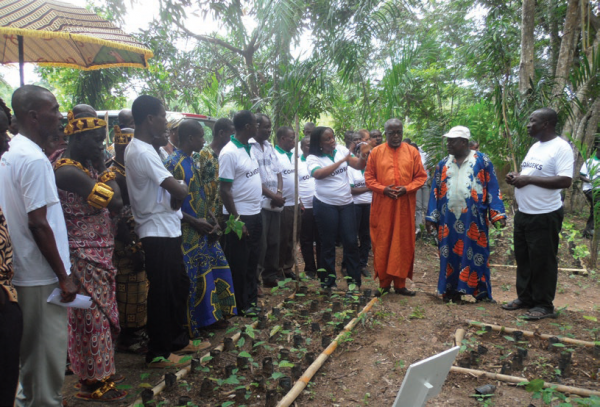
Local authorities and COMDEKS grantees visit nursery site, COMDEKS Ghana
Table G-2. COMDEKS Community-Led Projects on the Weto Range, Volta Region, Ghana
| Project | Grantee (CBO/NGO) | Contribution to Landscape Resilience Outcomes | Description |
| Multiple Land Use Practices for Sustainable Biodiversity Conservation and Livelihood Development through Integrated Production Systems in Agbateh, Tsibu, and Peki –Wudome Production Landscapes | Centre for Youth in Agricultural Development
US$25,140 |
Outcomes 2, 3, 4 | Strengthen capacity of local fire squads and other existing community institutions to participate in natural resource management. Train farmers in techniques suitable for slope farming, such as agroforestry and stone terracing, as well as organic farming methods. Invest in fish farming and bee keeping as alternative livelihoods. Document indigenous practices for conserving caves and other sacred features of the landscape. Develop participatory land use plans. |
| Reforestation and Livelihood Enhancement Project (RILEP) for Biodiversity Conservation & Sustainable Land Management Within the Weto Landscape Area of Kaira, Todome and Peki-Adzokoe Communities | Socioserve-Ghana
US$25,000 |
Outcomes 1, 2, 3 | Improve attitudes and practices of the local community members and traditional authorities in biodiversity conservation and sustainable land management. Build capacity of local clan leaders to implement conservation practices as part of traditional laws. Introduce agroforestry and sustainable farming practices, including multiple cropping and composting technologies. Establish 2 community nurseries for production and sale of plant materials. Establish 40 model reforestation activities to rehabilitate degraded lands. Support rearing of grass cutters, snails, and mushrooms as alternative livelihood enterprises |
| Sustainable Eco-Agricultural Development and Community-Based Natural Resource Management for Conservation of Biodiversity and Socio-Ecological Production Landscapes in Sanga, Dededu and Avenul Communities | Support Services Foundation
US$26,000 |
Outcomes 2, 3, 4 | Establish agroforestry as a viable income source by building a community nursery for fruit and timber seedlings and training 30 lead agroforestry farmers. Carry out extension programs for area farmers in soil, water, animal, and crop management using sustainable practices. Support interested farmers to invest in integrated livestock raising, snail farming, and mushroom growing as alternative enterprises. Set up 5 producer associations and develop value-added market chain. Support organizational development to help local organizations mature and sustain themselves over time. |
| Integrated Resource Management in the Weto Landscape for Livelihood through Community Mobilization and Institutional Collaboration in Bame, Kwanta and Wegbe | Volta Region Association of Beekeepers
US$25,000 |
Outcomes 1, 2, 3 | Encourage reforestation by establishing a central nursery for tree seedlings and training local groups in reforestation practices. Promote bee-keeping, livestock rearing, fish farming, vegetable production, and fruit and timber tree growing as alternative income sources, and construct ponds to collect run-off water to support these activities. Encourage famers cultivating slopes to adopt agroforestry. Establish resource management support center and product processing center. |
| Restoration of forest cover and conservation of biodiversity of the Nyagbo-Logba cluster of Weto landscape for the socio-economic transformation of the people | HATOF Foundation
US$21,200 |
Outcomes 1, 2, 3 | Strengthen community skills in biodiversity conservation and sustainable agriculture, providing training in sustainable tillage methods and composting. Establish tree nursery and provide training in agroforestry methods to help restore forest cover. Provide alternative sources of livelihood through establishment of demonstration farms and training in gari processing and rice farming; conduct outreach to schools and form environmental clubs to establish a conservation mindset in students. |
| Restoration of the Natural Forest within the Nyagbo–Fume portion of the Weto landscape for biodiversity conservation and wealth creation | Youth Aid Foundation for Winners
US$21,200 |
Outcomes 1, 2, 3, 4 | Reduce pressure on the mountain resources while reducing poverty by creating a local land use plan; establishing a community tree nursery; regenerating mountain forest cover with timber and non-timber species; training farmers in sustainable agricultural practices such as zero tillage and strip cropping; establishing demonstration farms; and providing training in bee-keeping, small ruminant rearing, citrus farming, and vegetable cultivation. |
| Livelihood promotion and institutional building for Natural Resource Management of Kpale, Etordome, Saviefe Gborgame, Agokop, Xorse and Anfoeta section of the Weto landscape for biodiversity conservation and wellbeing of the people | Green Globe Society International
US$25,600 |
Outcomes 2, 3 | Provide alternative livelihoods by supporting establishment of rural enterprises in livestock rearing, beekeeping, fruit tree cultivation, cocoa, and bamboo and rattan products. Construct a nursery to produce agro-forestry seedlings. Establish demonstration farms to teach organic methods and composting. Initiate a microcredit system to support farmers adopting sustainable methods. |
| Consolidation of Bio-diversity Conservation and Sustainable Livelihood in Have- Domefe, Have- Gborxome, Ando, Jerusalem, Aneta and Jordan portion of the Weto Range | Environmental Development Youth Movement
US$30,000 |
Outcomes 1, 2, 3 | Raise awareness of the need to protect the Weto range. Promote the regeneration of forest cover and biodiversity on 120 ha degraded areas in the Have –Domefe and Have-Gborxome areas. Develop alternative sustainable livelihood technologies for 200 farmers in the six beneficiary communities. |
| Weto integrated eco-cultural tourism and sustainable livelihood development project for the conservation of biodiversity and enhanced wellbeing of the people of Todome-Agate | The Development Institute
US$26,000 |
Outcomes 3, 4 | Develop the tourist potential of the Todome-Agate potion of the Weto landscape, including ancestral caves, watersheds, sacred groves, and wildlife habitats. Develop land use plans to integrate local agricultural production and tourism. Practice afforestation, establish community woodlots, and construct a community nursery for tree seedlings |
| Assessment, documentation and biological inventory of Sacred sites in the Kpeve Agate cluster of the Weto Mountain Range Ecosystem | Accelerated Rural Development Organization
US$6,000 |
Outcome 4 | Assess the status of sacred sites in the Kpeve-Agate Cluster on the Weto Range mountain ecosystem, document them for policy formulation, and develop the capacities of the local people for biodiversity conservation and sustainable management of the surrounding forest. |
Achievements and Impacts to Date
- Restoring forests and rehabilitating degraded land: Communities have established 18 tree nurseries, which have produced and distributed 1 million tree seedlings so far, which were in turn used to rehabilitate 850 ha of degraded lands using indigenous species including mahogany, ofram, and cedar. Another 2,500 ha of partially degraded forest have been placed under natural regeneration with enrichment planting, governed by traditional rules and regulations.
- Establishing community protected areas: An estimated 5,000 ha have been put under strict protection due to their ecological and cultural importance. These include areas critical to local water supplies, caves, fallow lands rich in herbs and other plant species, sacred sites and shrines, and ecologically sensitive areas such as erosion-prone slopes.
- Cataloging and assessing sacred sites: In the Kpeve-Agate area, communities have biologically surveyed and documented 20 sacred sites, which are often rich in biodiversity and cultural significance.
- Promoting agroforestry and training farmers in sustainable agricultural practices: Cash crops under agroforestry cultivation have been established, the main crops being cocoa, avocado, pear, oil palm, citrus, mango, and guava. Agroforestry technologies to support sustainable agriculture have been introduced to 500 lead farmers, 100 Community Trainers (CTs), and 120 Farmer Trust Groups. Sustainable land management techniques for soil fertility improvement, soil conservation, dry season gardening, organic farming and wildfire management have also been conveyed. For example, one project has established a conservation village and created a farmer field training school to provide demonstration sites, introduce new technology, and train small-scale farmers in the Weto range in sustainable agriculture techniques. Farmers have been trained in organic vegetable cultivation and the use of drip irrigation, which has brought permanent employment to over 200 farmers. In addition, the project has educated 800 small-scale women farmers on the need to protect the Weto range. These farmers have subsequently rehabilitated 220 ha of degraded land near Have-Domefe and Have-Gborxome with indigenous species and established a natural regeneration area of 1,000 ha to restore biodiversity.
- Introducing alternative income opportunities: Rural enterprises have been established in several areas. In the South Dayi District, for example, the Reforestation and Livelihood Enhancement Project has developed five enterprises: processing non-timber forest products (NTFPs) such as palm oil, moringa, honey, and mushrooms, and processing and packaging cassava (into gari) and fruit; integrated livestock rearing, using goats, pigs, rabbits, and grasscutters (a ruminant); development of fodder and feed banks for livestock; establishment of commercial fruit plantations; and honey production. Household incomes for those participating in these enterprises have in some cases increased 100 percent. A project in the Todome-Agate area has helped revive the local cocoa industry by supplying improved cocoa seedlings to over 200 farmers and initiating the process of obtaining organic certification for locally produced cocoa. Another project in the communities of Bwame, Kwanta, and Wegbe has empowered over 1,000 smallholder farmers in sustainable agriculture and environmental conservation through education and investment in apiculture as an enterprise. Over 8,000 beehives have been established, which has led to the conservation of about 2,200 ha of natural and semi-natural habitats and their associated ecosystem services. The project has attracted support from the Government of Ghana to build a honey processing and bottling plant in the area to help market the local product.
- Supporting local organizations and improving environmental governance: Since the implementation of local projects began, some 125 different community groups have been established in the Weto region to undertake the landscape work. At the same time, government authorities at all levels have shown their support for COMDEKS: all grantees have signed formal MOUs with the Ministry of Food and Agriculture, the Forest Commission. The Municipal and District Assemblies in the Weto area are also collaborating in the local projects, as is the Environmental Protection Agency. One important governance innovation has been the establishment of the Weto Platform, a group of civil society groups and traditional authorities that have agreed to work together to achieve integrated landscape governance in the Weto region.
- Influencing local planning and land management policies: Eight community land use plans have been prepared and endorsed by the traditional authorities. This has led to the enactment of 12 local byelaws to protect ecologically sensitive areas along the mountain ridge. One project has started the process of asking the state to establish a Community Resource Management Area (CREMA) in the Weto region. This involves the preparation of local constitutions to guide the management of the area. The South Dayi District Assembly is now deliberating on the constitution to pass a byelaw to back its management. If accepted, the Ministry of Lands and Forestry will devolve the legal authority to manage the area to the community.
- Teaching environmental awareness in area schools: Over 50 environmental clubs have formed in public and community schools in the area that serve to stimulate environmental awareness and teach conservation practices to the children. This is seen as a key strategy in building understanding and long-term demand for the landscape approach.
“COMDEKS is like a savior that has transformed our environment from brown to green and brought cash into our hands. Today we take care of our children by sending them to school; we buy clothes and are able to sustain our business, which was almost dying.”
–Madam Rose Kudese, Tafi Dekpor Community
Progress at the Landscape Level
All of the local projects in the Ghana portfolio have stressed adoption of agro-forestry and other sustainable and organic agricultural practices that can rehabilitate local watersheds and prevent future land degradation. They have also focused on creating new agricultural enterprises including bee-keeping, small ruminant rearing and snail farming, and ecotourism that can expand the region’s local economic base and create new livelihood opportunities. Since similar activities have been implemented throughout the target landscape, the additive effects of these activities should emerge relatively quickly. Connections and synergies among the projects are emerging. For example, the Volta Region Association of Beekeepers provides technical backstopping to the establishment of apiaries throughout the target landscape, and supports standardization and marketing of the honey. The management of Environmental Development Youth Movement supports other members of the platform with technical knowledge on organic agriculture, grafted mango promotion, and cultivation of indigenous leafy vegetables. Currently, Development Institute is supporting Youth Aid Foundation for Winners in developing the ecotourism potentials upon request. Although such synergies are in the early stages of forming, the networks for communication and sharing that are already active are encouraging. The most significant development in terms of landscape-wide governance has been the formation of the Weto Platform, which links different civil society groups, traditional authorities, and government bodies in a single institution with the goal of approaching natural resource management from a landscape-wide perspective. Initiated in 2012, the Weto Platform has been formally recognized by the Government of Ghana and granted considerable power over natural resource management policies in the region, as well as day-to-day decision-making and oversight at the project level (see Box G-1).
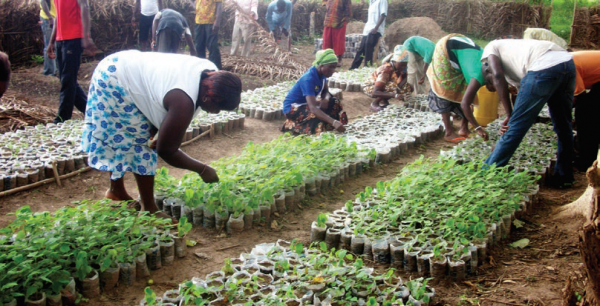
Nursery group transplanting seedlings, COMDEKS Ghana
BOX G-1. THE WETO PLATFORM
Governance structure
The Weto Platform has a three-tier governance structure: the Weto Governing Council, the Weto Consultative body and the local community groups. This structure and the Weto Platform itself has been registered and certified by the Government of Ghana.
a) The Weto Governing Council is a 11-member council made up of:
· Landowners within the Weto range (2): Participating NGO,s have facilitated the formation of the Weto landowners association from which one representative has been selected for the Weto Governing Council.
· Traditional Authorities (2): Chiefs along the range have nominated a representative.
· District Assemblies and Regional coordinating council (3): The District Chief Executives were involved in appointing 3 representatives to the council.
· Opinion Leaders (1): two Influential persons in the area were selected to the Council.
· Academia/Research institution (1): Existing institutions must be invited to form part of the council.
· Civil Society Organizations operating along the range (2).
Their functions include sourcing, dispersing, and managing support for the management of the natural resources within the Weto range. They approve of policies governing the management of the resources, settle disputes, and ensure political and social support for the management of the area. They approve the management plan and management of the landscape. They meet twice a year to deliberate on matters arising from the operations of the platform members and other matters affecting the welfare of the Weto landscape.
b) Weto COMDEKS Consultative Body (WCCB)
The following bodies form the consultative body:
o Representative from all the implementing CSOs under COMDEKS.
o Representatives of other CSOs operating in the area but not under COMDEKS.
o Collaborating Ministries, Departments and Agencies operating within the Weto range. These institutions are: Environmental Protection Agency, Forestry Commission, and the Ministry of Food and Agriculture. They have signed MOUs with the participating CSOs.
o Donors: GEF/SGP, IUCN and SNV, as well as other future donors.
o Media: all media house with coverage reaching the Weto range are represented.
The Consultative body takes the day to day decisions and drive progress of project activities. They monitor project progress, discuss the challenges and ensure peer review of project performance and ensure that the COMDEKS project is on course.
c) Local Groups
This group is made up of the various groups and associations formed under the COMDEKS project. They include the tree nursery groups, agroforestry development groups, bee honey production groups, tree planting groups, and the project management and implementation committees. They are involved in project implementation and participate in fora and congresses meant to propagate concepts of the WETO Platform. They are the project beneficiaries and therefore can advise project management on the appropriate measures to support the progress of the project.
The Organization Of The Weto Governing Council
o At the apex of the Weto Platform is the Weto Governing Council as the highest decision-making body. They are supposed to meet at least once but not more than twice a year, except on special occasions.
o The Weto COMDEKS Consultative Body (WCCB) follows directly under the Governing Council and implements the decisions of the council.
o Project Implementation Committees are the local groups. They meet as often as required to review projects and strategies for progress.
o At the base are the beneficiaries.
Lessons Learned
- Community members had been apathetic towards rehabilitating the degraded areas with indigenous timber species due to the unfavorable tree and land tenure system, which did not give them ownership over the restored areas. The COMDEKS program has changed local attitudes on this by utilizing the provisions of the new Timber Plantation Act, which does provide tree-planting incentives. As a result, many timber species are now being planted by local people.
- Introducing new cash crops has been important. The introduction of cocoa species in the conservation program, for example, has generated a great deal of interest, since it both helps restore biodiversity and generates income.
- Improving the governance structure of the landscape with the introduction of the WETO Platform has promoted community ownership of the project and has encouraged the citizens to take up other activities that will help manage the landscape more sustainably and productively.
- Efforts to promote ecotourism and cultural tourism have begun to revitalize local culture. With continuous community education and sensitization, the youth in consultation with their Chief and Elders, are reintroducing some of the abandoned annual festivals like the yam festival, which has not been celebrated for the past 30 years. This effort has been aided by the project to catalog sacred sites, which, as traditional protected areas, are natural ecotourism assets.
- The participatory land use planning concept that COMDEKS employs is not always well understood by community members. Some fear that it means land alienation, and have therefore been slow to embrace it. This has in some cases slowed reaching agreement with landowners on the appropriate sustainable land use practices, and emphasizes the importance of the public education and environmental awareness components of COMDEKS projects.
- The expectations of communities have been very high, but the collaborating institutions have not always been able to meet their commitments, a situation which has created anxiety. Managing community expectations has thus been very challenging.
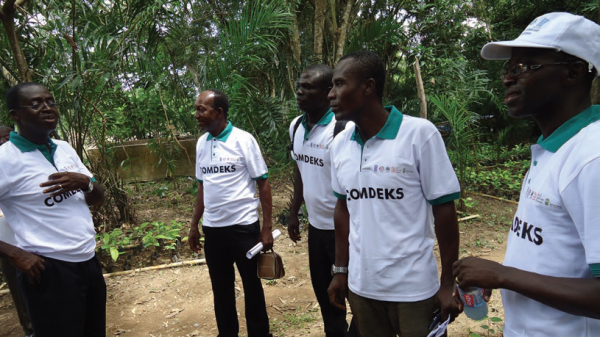
SGP National Coordinator visits grantees to monitor their project, COMDEKS Ghana

